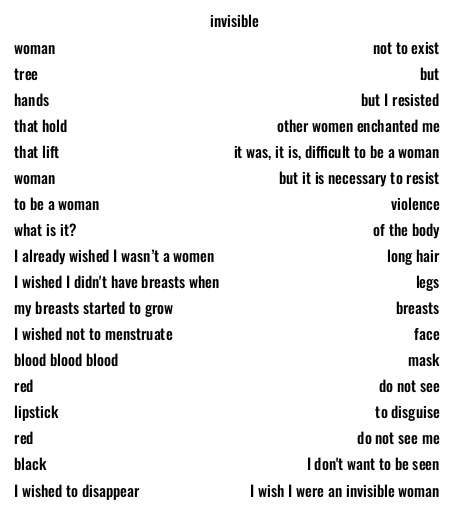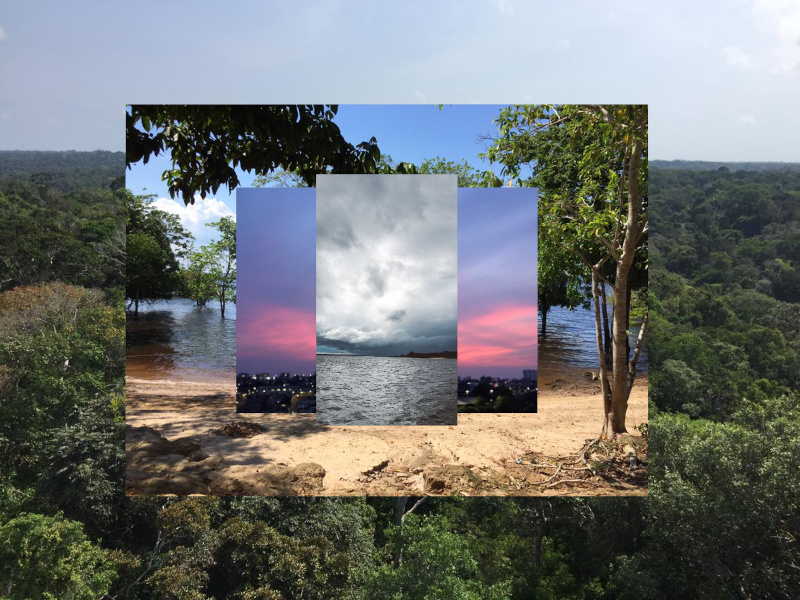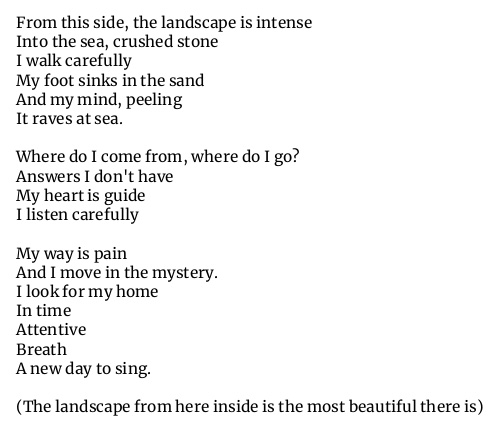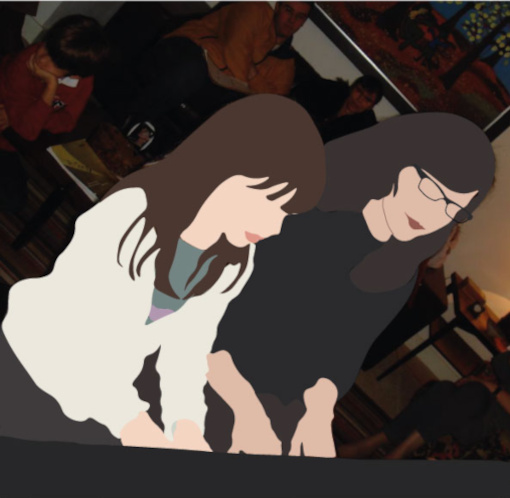
In between the lines: Listening to the inaudible, giving way to the unsayable
By Lílian Campesato and Valéria Bonafé
- View Lílian Campesato's Biography
Lílian Campesato is a Brazilian artist and researcher, affiliated with the University of São Paulo, whose works explore listening as a conflictual space in which voice and noise are central aspects.
- View Valéria Bonafé's Biography
Valéria Bonafé is a Brazilian artist and researcher, affiliated with the University of São Paulo, whose works explore the relationship between sonic composition, listening and subjectivity through creative-investigative practices.
In between the lines: Listening to the inaudible, giving way to the unsayable
By Lílian Campesato and Valéria Bonafé
"But since writing must take place, at least do not crush with words what is in between the lines"
— Clarice Lispector
Introduction
In this creative written piece we combine textual, visual and sonic elements to compose a reflection on listening that unfolds not only in the rational sphere, but which also seeks to activate sensitivities and affections. More specifically, we propose to build a discussion on the political potential of listening, taking as a reference one of the artistic-research actions that we have been developing within the project Microfonias: invention and sharing of listening. This action — which we call Dispatches — consists of engaging two or more people in non-verbal and asynchronous conversations that unfold in the form of correspondences of artistic nature. For this occasion, we worked with a group of women artists who engaged in the Dispatches action over the course of two weeks. By introducing and commenting on this artistic-research action and presenting the materials produced by the artists as part of this collective process, we want to build not a theorization about listening, but a reflection that, from the perspective of micropolitics, situates listening as an act of resistance.
We start from the assumption that there is a gap between what sounds and what is heard. This space, this in-between, unfolds a series of relationships, experiences, memories and affections that resist a direct description based on causal relationships and logocentric constructions. When it comes to describing an experience, there is always a gap between the experience and what we can say about it, because "any situation, any bit of practice implies much more than has ever been said" (Gendlin 1992, 201). In this in-between, it remains what can only be accessed through bodily and sensitive experience. This idea supports a montage experience that we undertake in this creative piece, in which a textual layer is laid out side by side with a layer composed of artistic works. These layers are not connected by a cause-and-effect relationship, but by resonance. What results is a creative piece that seeks to mobilise an inventive appreciation of the reflections we propose to establish.
Microfonias1 is a project that combines research and artistic creation, in which we take listening as both a practice and a subject of investigation. Our research is based on experimental actions, but it does not shy away from establishing relationships with a wide literature focused on critical studies on listening, including the fields of sound studies, philosophy, psychoanalysis and feminist studies. Since we started our activities in 2017, we have favoured lengthy processes that allow us to make room for invention, for intuition, and for what happens between the lines. The title of our project — Microfonias — expresses the desire to address the micro, what is usually considered insignificant or minor. Our focus is on the instabilities, weaknesses and vulnerabilities of the processes we move. By metaphorically evoking the phenomenon of feedback,2 the title of the project also points to the importance of noise, discomfort and estrangement, which result from a looping process that continuously articulates emission (projecting oneself to the outside) and capturing (listening to oneself).
The artistic-research action Dispatches is a creative and collaborative practice that we started at the beginning of the Covid-19 pandemic. A "dispatch" is any type of artistic production especially created and addressed to someone. It may be a small composition, a short performance, a sound miniature, a montage of images, a video, a poetry, a photograph, or any other sort of artistic production. Once created, it is dispatched to the recipient without any kind of contextualising message other than the title. After receiving it, the recipient begins a personal listening adventure, along with the creation of another dispatch to be sent in response to the original sender, moving the process onwards. The emphasis on the term "dispatch" is related to our interest in the process of addressing the other through listening. In other words, "a dispatch is an inscription of a singular listening urging on another listening" (Campesato and Bonafé 2022: 155). In this action, the deliberate decision of not establishing verbal contact during the process points to a desire of giving way to what is between the lines.
We developed the Dispatches action in three stages. Initially, we created and exchanged some dispatches between the two of us,3 seeking to experiment and understand the dynamics and effects of the action we were building. In a second moment, we synthesised this action in the form of an artistic proposition though a verbal-score,4 aiming to disseminate the action to other participants. Based on the analysis of this score and of some dispatches that we had produced, we then formalised a broad reflection on this action,5 which led us to open a discussion about the micropolitical potential of an action aimed at the invention and sharing of listening. Continuing and seeking to expand this artistic-research process, for this occasion we decided to bring together a larger group of participants to work with the Dispatches action. For this, we proposed a collaboration with Sonora: musics and feminisms,6 a feminist Brazilian network that has promoted actions to enhance and expand the participation of female and gender minority artists in music and sound art. Nine women artists who are members Sonora were engaged in this process — Amanda Jacometi, Carolina Andrade, Dani Sou, Eliana Monteiro da Silva, Georgia Cynara, Kely Guimarães, Marina Mapurunga, Sabrina Schulz and Tide Borges — in addition to four other women artists that were invited by them — Giulia Faria, Inês Mapurunga, Lara Blesa and Suzanne Schulz.
In this text we will present the set of materials produced by these artists during this collective creative process around Dispatches and some reflections on listening that we unfold from this experience. Our intention is not to describe or analyse each of the works that were created, but to expose them in a way that the images, sounds, videos and poetry that emerged in this process can be intertwined with our words. Adopting an essayistic type of writing, we will explore three aspects that have gained relevance in our analysis: the relationships that emerged between body and listening; the multiple mediations involved in the listening experience; and the forces that move and constitute listening.] With this, we want to cultivate a favourable terrain for the germination of some ideas about the potential of listening as an act of resistance, which will be discussed in the last section of this text. This discussion will be conducted in dialogue with the concept of sonic agency developed by the American artist and sound theorist Brandon LaBelle (2018). This concept will serve as a support structure for us to reflect on how sound thinking can affirm forms of resistance and emancipatory practices.
i) Bodies in listening
The overlap of body and listening may seem as obvious as it is problematic. As soon as one overcomes the limited idea of the body as a material aggregate of organs and listening as the triggering of one of those organs — the ear — we are faced with a myriad of relations, many of which diffuse, incomplete, mutant. Do we listen with the body? By means of the body? In the body? Or then: can we think of listening without the body?
Dispatch 1 - Desliga o shield [Turn off the shield]
from Tide Borges to Georgia Cynara
Dispatch 2 - Pipoca não é xarope [Popcorn is not syrup]
from Georgia Cynara to Tide Borges, in response to Desliga o shield
At least in terms of common sense, the pair body-listening bears immediately upon two poles. On the one hand, it pertains to a material aspect, where the body appears as a support structure for our very being while listening to a process activating our auditory apparatus. On the other hand, a connection with a subject seems to impose itself: it is difficult to think of a body without associating it in some way to selfhood, just as it is a challenge to uncouple the understanding of listening from the action and intentionality of a subject. This oscillating movement between subject and object unfolds in a manifold of polarizations: mind and body, concept and matter, concreteness and abstraction. Even if such polarizations are difficult to escape, it is far from our interest to fuel them.
In Dispatches, we propose to weave the space of the between, of relations. Contrary to trying to unpack an idea of the body and then an idea of listening, with Dispatches we want to make room for a complex network of mediations emerging from frictions between body(ies) and listening(s). But before anything else, we need to add some type of consistency, volume, to the word "body". Here, a representational idea of the body does not interest us. Rather, what we have in view is a singular, heavy body that gives form and is formed by its own contingencies and experiences. It is a body which affects and hurts itself. It is in this body that listening invents sound, that it imagines sound instead of receiving it passively. Sound isn't simply a sequence of quivering compressions and decompressions of air but the weaving of elements in resonance, which includes our bodies. The body helps constitute listening; listening helps constitute the body.
Dispatch 1 - Sob os escombros do amor [Beneath love havoc]
from Dani Sou to Marina Mapurunga

Dispatch 2 - invisível [invisible]
from Marina Mapurunga to Dani Sou, in response to Sob os escombros do amor
Both, body and listening, have been widely considered by theories, modulated by technologies and exercised by art. Right when literary analysis began incorporating the reader as part of the text, the Swiss linguist Paul Zumthor (2007) perceived the trace of the action of bodies on things and of things on bodies. Asking what role the body has in reading a text, he understood that what we read is not only in the text but in everything around it: in culture, in the context, in the reader. Reading, then, is realisation, recognition, the passage from a field of virtualities to actuality. In a word, reading a text is a performance, it modifies and marks the knowledge of a text. The same could be said of listening (and isn't reading a way of listening?).
"My body is the materialization of that which is my own, it is lived reality and determines my relation with the world. Endowed with unmatched signification, the body exists in the image of my being: it is my body I live, possess and am, for better or worse. Ensemble of tissues and organs, support to psychic life, the body also suffers social, institutional, juridical pressures which, no doubt, pervert its primary impulse. I make the effort not so much to apprehend it but rather to listen to it, at the level of the text, everyday perception, in the sounding of its appetites, its sorrows and joys: contraction and decontraction of muscles; tensions and internal relaxations, sensations of void, of wholeness, of swollenness, but also of flaming heights and their falls, the feeling of a threat or, on the contrary, of an intimate safety, opening or affective fold, opacity or transparency, joy or pity stemming from a diffuse representation of oneself" (Zumthor 2007, 23-24).
While listening, we adopt a position and framework of a sound field just as we are frameworked by it. [Listening has to do with the materiality of sound, but it isn't restricted to it. The song which recalls a childhood scene or the expectation of the bang of a door about to slam are listening constructs which depend on concrete experience, on a performance. The concreteness of the action implies the presence of a body which is neither transcendental nor abstract, but existing, and tangible.
ii) Mediations in listening
The performative body creating the action allows us to think of listening not as reception but as a process of sound construction and performance, that is, "a modality of thought that emerges from embodied experience in the context of particular relational situations" (Souza-Lima et al 2021, 29). In this perspective, listening can be described as an embodied act of thought (Souza-Lima et al 2021, 30), as an act producing sound images by means of an experience and multiple mediations transcending the dualities between subject and object. If listening involves the power of incorporating a particular act of thought, in listening we have the possibility of displacing the thinking constituted in the abstract sphere of the self towards the sphere of the body and the lived situation. This displacement is only possible once the subject is understood as an assemblage, as a relational process composed by heterogeneous agents. From this perspective, the subject constitutes itself outside-the-subject, in experience, in contact with the other and with lived events. It is a point of view allowing for a broader understanding of the particular effects of encounters on bodies.

Dispatch 1 - Paisagens de onde vim [Landscapes where I came from]
from Kely Guimarães to Amanda Jacometi

Dispatch 2 - Palavra-pássaro [Word-bird]
from Amanda Jacometi to Kely Guimarães, in response to Paisagens de onde vim
Working from this understanding of listening as performance, we intend to open two doors in the aural domain. First, we want to lighten as much as possible, the need to assume the body and listening from a predominantly human perspective. This does not imply simply inverting the tendency of moving from subject to object, people to things. The field of material culture has made explicit the fact that we not only interpret or act upon things, but they also have agency upon us. In the case of listening, this implies questioning its anthropocentric character in order to recognize just to what extent it also constitutes itself outside ourselves. We can think, for instance, of the listening of a machine (is it not this what microphones do?) or of an animal (they also have ears!), but we can also think just to what extent listening is formed by surroundings, by noises and its sonorous sources, by social, political and aesthetic forces determining what can and cannot be heard, what is possible to hear and what is not possible to hear. This becomes apparent whilst listening to an unknown language, comparing the sound of a live performance to that of a recorded one, or when one is moved bodily by political slogans in a demonstration or by a subwoofer in a dance club. What shapes listening isn't only the sound, taken as an autonomous entity. Neither is it the listener, understood as a predetermined subject. Listening is shaped by forces, differences and resonances activated here and now by a singular experience extrapolating the human dimension, making listening drift into a more-than-human sphere.

Dispatch 1 - Mãe [Mother]
from Marina Mapurunga to Inês Mapurunga

Dispatch 2 - Saber-viver [Know how to live]
from Inês Mapurunga to Marina Mapurunga, in response to Mãe
This process of resonance — transmission of vibratory movements between different bodies — addresses the second door we want to open: listening as relation. Placing oneself directly in relations themselves allows for unforeseen processes and elements to be considered. To understand relations it is necessary to take into consideration the existence of other actors, other affects, other places. It is a perspective which displaces the centrality of the subject and object to focus on what is between them, in the lines connecting them. When we listen to a music or a sound of some sort, we necessarily are affected by a wave of material and immaterial variables, which help put together that listening: the mode of production of sound waves, the quality of the air as medium, the acoustic conditions of the space, the physiology of the ear, memory, knowledge, emotions, imagination. The relational aspect of listening is directly tied, therefore, to its multi-mediated character.
Dispatch 1 - Fluxos [Flows]
from Sabrina Schulz to Suzanne Schulz
Dispatch 2 - Reflexo [Reflextion]
from Suzanne Schulz to Sabrina Schulz, in response to Fluxos
The notion of sound's multiple mediation is at the core of the discussion that Georgina Born (2019) proposes about a non-anthropocentric and non-anthropomorphic theory of sound.7 To investigate the relational potential of sound, she shares two auto-ethnographic listening accounts strongly impacted by nonhuman sounds: a random episode of involuntary immersion in the sound of a storm, and the prolonged and intentional relation with the sound of the hospital bed where her mother spent the last days of her life. By non-human sounds, Born therefore refers to sounds that do not originate from intentional human acts, such as, for example, the sounds of nature or the sounds of things. However, even though they do not originate in human acts, these sounds accompany and affect our daily life, profoundly composing our listening experience. While analysing her two listening experiences, Born grasps sound as "an inherently relational and 'mediational' phenomenon that overcomes dualistic understandings of subject and object" and that "participates in subjectivity" (Born 2019, 198).
Similarly, in our experience with Dispatches, listening also appears as a hybrid assemblage, as an intrinsically relational and mediational phenomenon, being translated into a constellation of heterogeneous mediations composed by material and immaterial elements and processes, elements and processes both sensory and non-sensory, mental and bodily, physical and affective, individual and collective, human and nonhuman.
iii) Forces in listening
Listening as performance; listening as an embodied act of thought; listening as relation; listening as hybrid assemblage. Rather than stabilising concepts of listening, these propositions help us displace listening towards the field of its very production. What interests us isn't listening as simple receptivity but the vital forces impregnating the production of listening. Considering listening from the viewpoint of its production allows us to question, for instance, how singular listenings are produced, ones escaping dominant mechanisms controlling subjectivity in contemporary society.
Brazilian psychoanalyst and cultural critic Suely Rolnik (2018) argues that contemporary capitalism draws its strength from economic exploitation but also from the expropriation of our subjectivities. For her, this expropriation operates through the submission of subjectivities to prevailing economic and ideological mechanisms, such as productivism, commodification, individualism, racism, and machismo. We argue here that these mechanisms also support hegemonic modes of listening, which shape what we are able to hear and the way we listen, neutralising the inventive, noisy, subjective and relational character of listening. These dominant forms of listening tend to nullify "the experience of otherness, blocking the effects of forces arising from the other on our bodies" (Bonafé and Campesato 2022). Just as with the mode of subjectivation of the colonial-capitalist regime, these listening modes have numbed our vulnerability to the forces of the world, disavowing all and any otherness experience. But how can we resist these dominant forms of listening? How can that which is frequently silenced, inaudible or unsayable, be heard, listened to?
Dispatch 1 - Cantar é um ato de resistência [Singing is an act of resistance]
from Carolina Andrade to Giulia Faria
Dispatch 2 - Dos gritos e cantos calados (ou não) [About silenced cries and chants (or not)]
from Giulia Faria to Carolina Andrade, in response to Cantar é um ato de resistência
Dispatches is configured as an experimental practice of invention and sharing of listening that confronts the hegemonic listening modes in contemporary society, pointing towards a "feminist politics of listening, which values random aspects, apparently insignificant, yet intimate, singular" (Bonafé and Campesato 2021: 142). What we want to give up are the limiting discursive forces which usually impose themselves on listening; what interests us is a listening produced between the lines, in noise. In this practice of artistic correspondence, the unsayable gains force in the production of every dispatch, just as the inaudible seems to knock on the recipient's door. An exercise where listening rebels against its dominant forms of control and leaps towards the vital force of the inaudible and unsayable.
Dispatch 1 - Arte é resistência [Art is resistance]
from Eliana Monteiro da Silva to Lara Blesa

Dispatch 2 - De mão em mão [Hand in hand]
from Lara Blesa to Eliana Monteiro da Silva, in response to Arte é resistência
This collective exercise of inventing and sharing listenings reveals a disjunction between that which can be said and that which can be heard: the unsayable makes the presence of the inaudible jump and vice-versa. What remains are "traces of this experience, effects produced precisely on the basis of ambiguities, hesitations, openings" (Campesato and Bonafé 2022: 163). In Dispatches, we potentialized the force of what "is between the lines and which, after all, constitutes the entirety of the listening experience" (Campesato and Bonafé 2022: 163).
Reverberations: Listening as resistance
Tide Borges and Geórgia Cynara, longtime friends, tuned in to the impact and transgressive lightness of laughter in her dispatches Pipoca não é xarope [Popcorn is not syrup] and Desliga o shield [Turn off the shield].
Dani Sou felt that in Sob os escombros do amor [Beneath love havoc] she was able to access something that was buried and that wanted to be released and was surprised by the resonances she listened in invisível [invisible], sent by Mariana Mapurunga in response.
Thorugh Paisagens de onde vim [Landscapes where I came from] and Palavra-pássaro [Word-bird], Kely Guimarães and Amanda Jacometi identified with each other in their recent migration processes, sharing the challenge of resisting amidst the concreteness of an unknown metropolis.
When receiving Saber viver [Know how to live], Marina Mapurunga wondered if her mother Inês Mapurunga had realized that her dispatch Mãe [Mother] had the image of two and not just a little monkey, mixed in one body.
In Fluxos [Flows], Sabrina Schulz said that she had looked for another way to talk to her twin sister Suzanne Schulz, with whom she had fought a week before, and whose response — Reflexo [Reflextion] — was received as a final point in the discussion.
Carolina Andrade and Giulia Faria — who maintain a long musical partnership, but who live in different countries — dealt with the longing to be together and the discomfort with the public representation of women in Cantar é um ato de resistência [Singing is an act of resistance] and Dos gritos e cantos calados (ou não) [About silenced cries and chants (or not)].
In Arte é resistência [Art is resistance] and De mão em mão [Hand in hand], Eliana Monteiro da Silva and her nice, goddaughter and former piano student Lara Blesa rescued memories of their conviviality over time.
The conversations that followed the collective dynamics of sharing revealed the potential for noise in communication, the divergences and convergences of meaning, the between the lines involved in what is not said, the need not to repress what must be said, the misunderstandings, the desire to address the other, the connections between people, places and affections, the memories and the related contexts, a space of trust and an effort to try to understand the other, the possibility of hearing oneself in the other and of saying what one cannot be said otherwise.
Identification and estrangement, openness to vulnerabilities, access to the inaudible and unsayable. By activating a variety of subjective and artistic capacities and potentialities, the Dispatches action turns to a micropolitical dimension of sound, operating as a sonic agency. Brandon LaBelle presents the notion of sonic agency as a means "to consider how particular subjects and bodies, individuals and collectivities creatively negotiate systems of domination, gaining momentum and guidance through listening and being heard, sounding and unsounding particular acoustics of assembly and resistance" (LaBelle 2018: 22). Through the notion of sonic agency, LaBelle explores how a sonic sensibility may inform and sustain emancipatory practices.
In the epistolary exchanges between this group of thirteen women, sonic agency resonated in the artists' desiring posture of listening and being listened to, and was reflected in their auditory expectations and imaginations for what was to come. They immediately triggered curiosity and moved to respond to each other's call through artistic production. A movement that already implied the other in the creative process. In the course of this action, these women celebrated the bond, the encounter, opening their senses and letting their guards down. They formed a community founded on mutual care and collective solidarity, inspiring and nurturing each other.
In Dispatches, the non-verbal conversation operates as a micropolitical practice destabilising dominant forms of listening.8 It is an attempt to escape from the oppression listening suffers, from the hegemonic processes of capture of the vital force. These hegemonic modes corroborate an understanding of listening as a passive and non-inventive experience; an object-oriented listening, aseptic, individual and univocal; an idealisation of listening forged in the mode of subjectivation typical of the colonial-capitalist regime, which is based on colonialism, patriarchy, extractivism, individualization and the commodification of relationships. Processes such as these reduce the experience of listening to a specific field of control, neutralising the complexity of the effects of forces arising from the other on the body and impeding the emergence of virtual worlds.
With this action we seek to favour poetical and political practices of insurrection against the crushing promoted by narcissistic listening (Bonafé and Campeasto 2022) — proper to a subjectivity reduced to a solipsistic subject — or by zombie listening — instilled in bodies already emptied of energy, subjugated to an extractivist politics of desire.9 In a nutshell, we seek to activate the vital force of listening, which implies breaking with the mollified scene of the institute and affirming the inventive character of listening and creating conditions for the emergence of listenings that are often repressed.
Listening to the other listening, and being conscient to the agency brought by shared listening experiences can reveal the potential of the vital force of listening and understanding it as an act of resistance. In this sense, Dispatches contributes to a culture of emancipatory practices through listening. From the political point of view, Dispatches implies opening listening to the inaudible while facing the dominant forms of listening that block the effects of the forces constituting it. From the poetical point of view, it implies giving way to the unsayable, transposing the silence imposed by dominant forms of discourse and artistic expression. From the ethical point of view, it implies orienting oneself towards a relational ethics founded on intensive resonance that cherishes shared experimentation, fosters differences and is committed to upholding a circulating flux of affects.
Works cited
Bonafé, Valéria, Campesato, Lílian. 2021. "'Many voices, resonating from different times and spaces': a script for an imaginary radiophonic piece on Janete El Haouli." Feminist Review, Sonic Cyberfeminisms, 127, 141-149.
Bonafé, Valéria; Campesato, Lílian. 2022. "Affective reports: from listening to writing, from writing to listening". OEI - Aural Poetics, edited by Michael Nardone.
Born, Georgina. 2019. "On nonhuman sound: sound as relation." In Sound Objects, edited by James A. Steintrager and Rey Chow, 185-210. Durham, N.C.: Duke University Press.
Campesato, Lílian; Bonafé, Valéria. 2022. "Dispatches: Cartographing and sharing listenings". In The Body in Sound, Music and Performance, edited by Linda O Keeffe and Isabel Nogueira, 153-164. London and New York: Routledge.
-- 2021. "Envios" (verbal-score). In 32 instruções para escutar (n)a pandemia, edited by Rui Chaves e Fernando Iazzetta. S[ão Paulo: Selo Berro.
Gendlin, Eugene. 1992. "The Wider Role of Bodily Sense in Thought and Language." In Giving the Body Its Due, edited by M. Sheets-Johnstone, 192-207. Albany: State University of New York Press.
LaBelle, Brandon. 2018. Sonic Agency: Sound and Emergent Forms of Resistance. London: Goldsmiths Press.
Rolnik, Suely. 2018. Esferas da Insurreição: notas para uma vida não cafetinada. São Paulo: N-1 edições.
Souza-Lima, Henrique. Germano, Gustavo. Campesato, Lílian. Esteves, Lúcia, Mapurunga, Marina, Bonafé, Valéria, Reis, Vicente. 2021. "Between Control and More-than-Human Events: The Listening Experience in the Light of Speculative Pragmatism." AM Journal of Art and Media Studies 24, 29-39.
Zumthor, Paul. 2007. Performance, recepção, leitura. São Paulo: Cosac-Naify.
Footnotes
- For more information, see: https://microfonias.net ↩
- The audio feedback phenomenon is called "microfonia" in Portuguese. ↩
- Examples available at: https://microfonias.net/dispatches ↩
- Campesato and Bonafé 2021. ↩
- Campesato and Bonafé 2022. ↩
- For more information, see: http://www.sonora.me ↩
- By mediation Born is thinking of "the bidirectional transmission, translation, and transformation of one relatum (e.g., sound) by another relatum (e.g., technologies, discourse, socialities, sites, and spaces)" (Born 2019, 203, endnote 2). ↩
- A broader discussion about dominant forms of listening is provided in Souza Lima et al, 2021. ↩
- The hegemonic modes of listening produced by contemporary society reinforce the psychic structure of narcissism. There is something important in the Narcissus myth that is often overlooked: by falling in love with his own image, Narcissus becomes deaf. That is, because he is trapped in his image, he is unable to listen to the other. And, thus, reduced to a solipsistic world in which the other is annulled, this subject becomes a living dead, a zombie, since the power to transform life is precisely in the confrontation with the other, different, unknown. ↩

